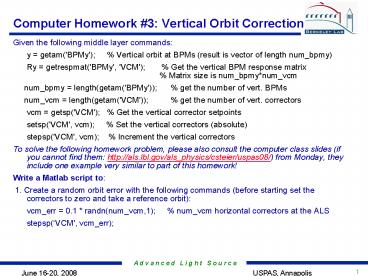Computer Homework PowerPoint PPT Presentation
Title: Computer Homework
1
Computer Homework 3 Vertical Orbit Correction
- Given the following middle layer commands
- y getam('BPMy') Vertical orbit at BPMs
(result is vector of length num_bpmy) - Ry getrespmat('BPMy', 'VCM') Get the
vertical BPM response matrix
Matrix size is num_bpmynum_vcm - num_bpmy length(getam('BPMy')) get the
number of vert. BPMs - num_vcm length(getam('VCM')) get the
number of vert. correctors - vcm getsp('VCM') Get the vertical
corrector setpoints - setsp('VCM', vcm) Set the vertical
correctors (absolute) - stepsp('VCM', vcm) Increment the vertical
correctors - To solve the following homework problem, please
also consult the computer class slides (if you
cannot find them http//als.lbl.gov/als_physics/c
steier/uspas08/) from Monday, they include one
example very similar to part of this homework! - Write a Matlab script to
- 1. Create a random orbit error with the
following commands (before starting set the
correctors to zero and take a reference orbit) - vcm_err 0.1 randn(num_vcm,1) num_vcm
horizontal correctors at the ALS - stepsp(VCM', vcm_err)
2
Homework 3 (continued)
- For the following parts remember for loops in
Matlab (gtgthelp for), as well as the possibility
to add new data to a vector (like
yrms(loop)std(gety) with loop being incrmented
in the for loop). - 2. Correct the orbit using various numbers of
SVs - a. Plot the singular values (i.e. the
diagonal elements of the matrix S after the SVD
inversion) of the response matrix (using
semilogy) - b. Plot the remaining RMS and Max orbit error
(std and max(abs)) vs. of the singular values
used in the orbit correction (the example in the
computer class used 48). - i.e., plot the orbit error when 1 sv is
used, 12 sv, 13 sv, 14 sv, etc. (up to
num_vcm) - Important Do not forget to remove previous
correction before applying new one! - c. Plot the total corrector strength change
(sum(abs(DeltaVCM))) as well as total strength
plus initial error (sum(abs(DeltaVCMvcm_err)))
vs. - of the singular values used.
- d. How many singular values would you
recommend using? - Now remove the random orbit error (removing what
you did in 1.) and only put one big error in, set
any of the VCMs for example to 1 A. - Repeat step 2. a-d above. Does the optimum
number of SVs change?
PowerShow.com is a leading presentation sharing website. It has millions of presentations already uploaded and available with 1,000s more being uploaded by its users every day. Whatever your area of interest, here you’ll be able to find and view presentations you’ll love and possibly download. And, best of all, it is completely free and easy to use.
You might even have a presentation you’d like to share with others. If so, just upload it to PowerShow.com. We’ll convert it to an HTML5 slideshow that includes all the media types you’ve already added: audio, video, music, pictures, animations and transition effects. Then you can share it with your target audience as well as PowerShow.com’s millions of monthly visitors. And, again, it’s all free.
About the Developers
PowerShow.com is brought to you by CrystalGraphics, the award-winning developer and market-leading publisher of rich-media enhancement products for presentations. Our product offerings include millions of PowerPoint templates, diagrams, animated 3D characters and more.

